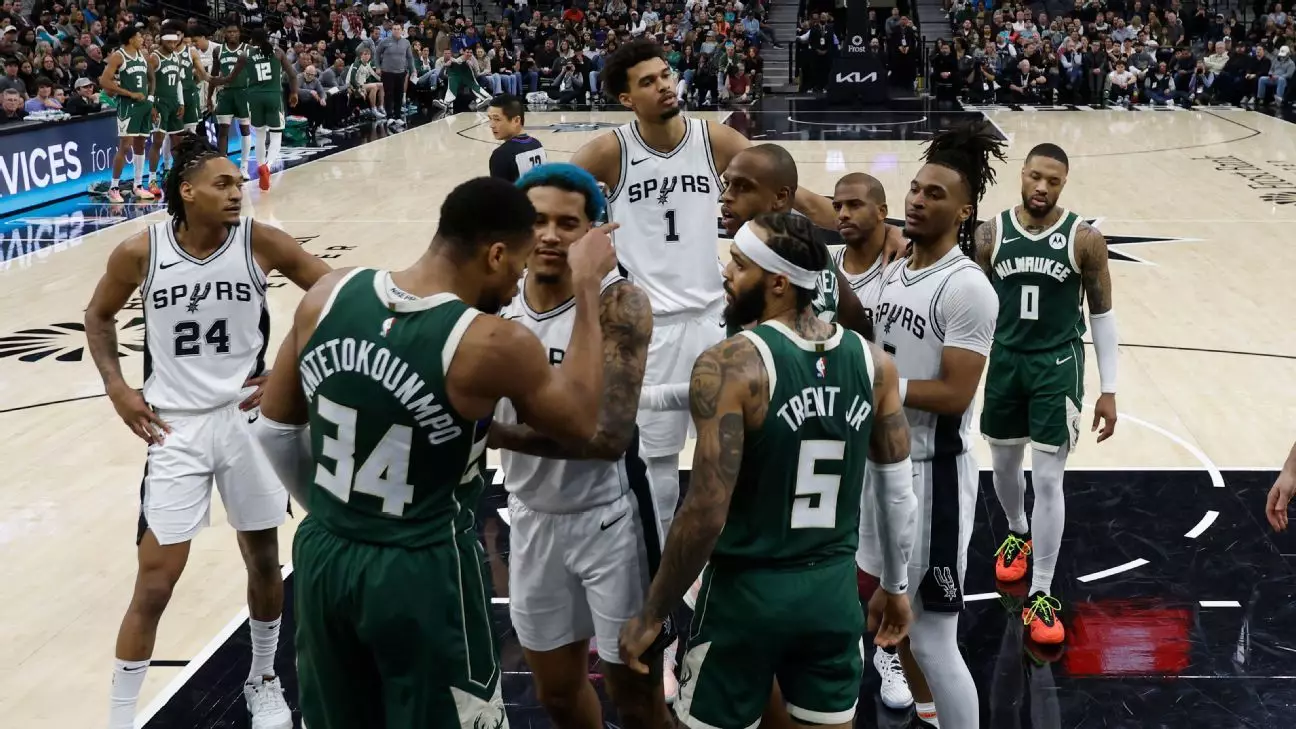The dynamic world of professional basketball is often characterized by intense competition, remarkable athleticism, and emotional display. However, sometimes these elements can transcend mere rivalry and enter a realm of heated confrontation. A notable instance of this occurred during a recent game between the Milwaukee Bucks and the San Antonio Spurs, leading to a situation that underscored the fine line between sport and aggression.
On a pivotal Friday night showdown, the Bucks found themselves in a lopsided battle against the Spurs, ultimately falling 144-118. This scoreline not only indicated a challenging game for Milwaukee but also set the stage for an incident involving the star player, Giannis Antetokounmpo, and veteran Spurs guard Chris Paul. With just under four minutes remaining in the game, tensions escalated when Antetokounmpo was fouled hard by Paul. This incident proved to be the tipping point in a match that was reflective of much larger emotions at play.
Antetokounmpo, known for his poise on the court, was left visibly frustrated after hitting the wooden floor due to a hard shove from Paul while attempting a drive to the basket. Such physical plays are not uncommon in the NBA; however, the nature of this foul and the subsequent reactions from both players turned a standard foul into a potential confrontation.
Even after the game concluded and the final buzzer sounded, Antetokounmpo took the proactive step of waiting near half-court to address Paul directly. This reflects a level of respect but also reveals how strongly emotions were running following the incident. Rather than letting it slide, Antetokounmpo’s actions signified unresolved feelings about respect and boundaries within competitive play.
“This is not just a game; it’s also about our personal lives and how we conduct ourselves,” he later relayed to reporters. His comments suggest he views such moments not just through the lens of competitive sportsmanship but also personal integrity and professional dignity. He articulated, “I have a family to feed, and what makes you laugh can also make you cry sometimes,” implicitly pointing to how such incidents can have real-world implications beyond the sport itself.
The reactions from teammates and coaches further illuminate the incident’s gravity. Milwaukee’s coach, Doc Rivers, noted Antetokounmpo’s typically level-headed nature, hinting that it takes considerable provocation to elicit such frustration. Rivers’ remarks signify the respect Antetokounmpo commands not only among fans but also from his peers within the league.
Given this context, the confrontation could resonate as a pivotal lesson in understanding emotional thresholds within the highly competitive framework of the NBA. The presence of other players, including Spurs rookie phenom Victor Wembanyama and Bucks player Gary Trent Jr., playing roles in mitigating the situation, underscores the community aspect of the league and the collective responsibility players bear to maintain sportsmanship.
Amidst the chaos, it’s vital to recognize the exceptional performances that characterized the game itself. Antetokounmpo, despite the emotional turmoil, delivered a stunning performance with 35 points, 14 rebounds, and six assists—highlighting that even under pressure, his play remains top-tier. This achievement also tied him with the legendary Kareem Abdul-Jabbar for the franchise record of most consecutive games scoring 35-plus points with at least ten rebounds.
On the other side, Wembanyama showcased his rising talent by securing 30 points, 10 rebounds, and five blocks, further indicating that San Antonio’s future is bright with him at the helm. Additionally, the Spurs as a team set a franchise record for three-pointers made, reflecting their offensive prowess despite the intensity of the game.
The incident between Antetokounmpo and Paul serves as a microcosm of the broader dynamics within professional sports—a reminder that while competition drives players to extraordinary heights, it can also ignite deep-seated emotions. As the NBA continues to thrive, understanding these emotional undercurrents and their potential consequences may become crucial for players, coaches, and fans alike. Ultimately, it raises the question: how do we navigate the fine line between competitive spirit and personal respect? In a high-stakes environment, it’s essential to ensure that both the game and the players’ integrity remain intact.


Leave a Reply